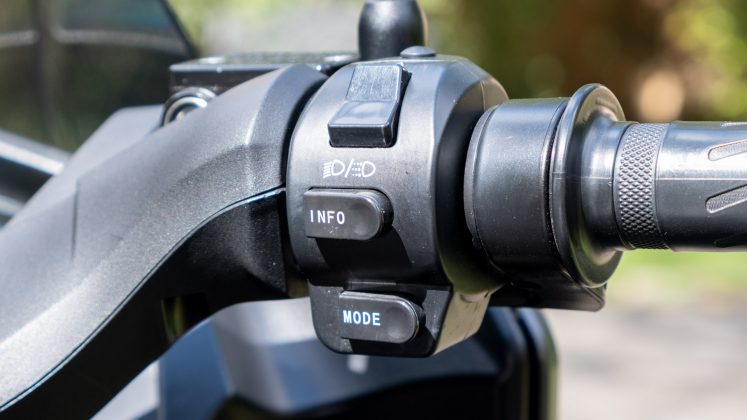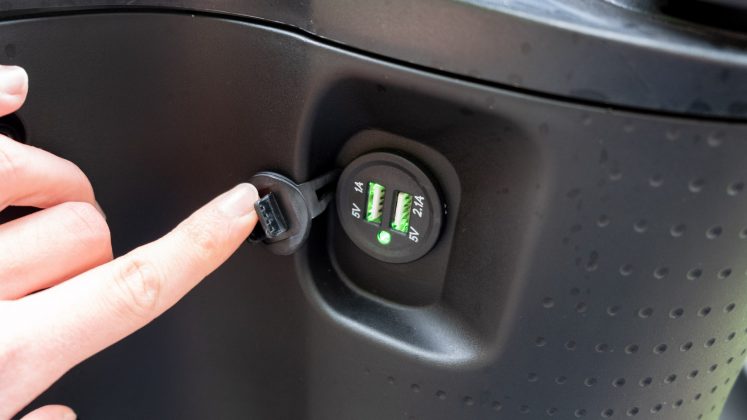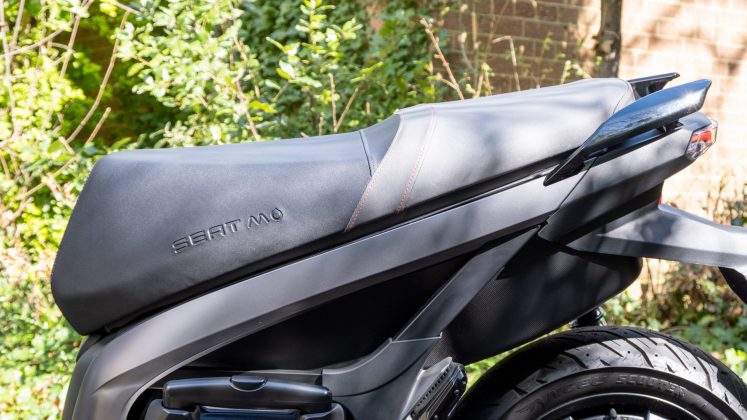Seat, the automaker, has decided to delve into the world of electric motorcycles with the introduction of the Mo 125. To help it transition into a new market, Seat partnered with fellow Spanish manufacturer Silence, a Barcelona-based company dedicated to the design and manufacture of two and three-wheel electric vehicles as well as their batteries.
If you’d prefer to watch a review of the Seat Mo 125, head on over to our YouTube channel.
Seat Mo 125 price & competition
Indeed, the Seat Mo 125 is essentially a rebadged Silence S01. Surprisingly, however, the former is cheaper at £5,800 versus the latter, which costs £6,265. Both bikes have a claimed range of up to 85 miles from their 5.6 kWh battery pack and will get up to 59mph.
Prices aside, the Mo 125 comes with a two-year design and manufacturing warranty with unlimited mileage, while the battery pack comes with a manufacturer’s four-year or 25,000-mile warranty, whichever comes first.
Buy the Seat Mo 125 from Auto Trader
As for its competitors, there are a few on the market. Here are some that we’ve reviewed, which you might want to consider for your city commutes: the Sunra Miku Super at £3,499, the Sunra Robo-S electric at £3,299, the Super Soco TS Street Hunter at £3,799, and the Super Soco TC at £3,399.
To ride any of the aforementioned bikes, you will need to pass your CBT, which in the UK can be done if you hold a provisional driving license or of course, one can attain an A1 license.
Read next: Sunra Robo-S review: A stylish all-electric scooter
Seat Mo 125 design & features review
In comparison to some of the alternatives, the Mo 125 has a unique and innovative battery design. See, unlike many that require you to faff around with the under-seat compartment or carry around heavy batteries in both hands, the Mo 125’s 5.6 kWh battery pack can be wheeled out like carry-on luggage. Indeed, all it takes is for the bike to be on its centre stand and for you to release the battery from the bike by pulling on a lever found within the storage compartment. This solution makes it far more attractive for those who require to charge the battery pack externally, say at work or if they don’t have a garage at home.
However, this does also present itself with other challenges. Due to the battery pack having only two wheels, it can only be wheeled across flat surfaces. If there’s a flight of stairs or even a high curb, you’ll be left stranded, namely if you’re descending. Due to the battery pack’s mechanism, which is required to fit into the bike and its 40kg weight, it’s impossible to negotiate any steps whatsoever. So, while the Mo 125’s battery pack is innovative, it could also be seen as a major sticking point for some consumers.
Aside from the battery pack, the electric moped is rather stylish with its sleek-looking LED lights at the front and rear. A small point to make, however, is that when the main beam is turned on, the side lights get disabled – for visibility to other motorists it would have been appreciated to have these running in tandem. Nonetheless, we can’t otherwise fault the bike’s aesthetics; it’s available in three colour finishes: Daring Red, Oxygen White Matte, and the pictured Dark Aluminium. Note, should you want to be better protected from the elements you can purchase a High Screen for £183.50.
Buy a phone mount on Amazon (Affiliate)
Regarding manual handling, the 152kg moped is relatively easy to manoeuvre, especially if you’re still sitting on the bike as there’s a reversing function. This can propel you backwards at up to 4mph, so you’ll want to be careful if you’ve got a pillion. When parked, there are sturdy centre and side stands that provide ample support.
When it comes to interacting with the bike, there are your usual switches. Unlike many of its competitors, there’s a push-to-cancel indicator switch making it easier to disable after taking a corner. However, when indicating there’s an annoying beeping sound that emits from the bike. One can understand the logic here, as it alerts pedestrians but it would have been appreciated if it could be disabled – some will dislike the bike making a very audible noise when turning. Equally, one might have expected more robust buttons, as all of them feel flimsy, namely the plastic indicator switch which sometimes refuses to initiate due to its fragile design.
Similarly, both the front and rear seat creak when sat on. This can be heard at a standstill or while on the move. It would seem the noise comes from the plastic material that resides underneath. It’s rather noticeable and you can hear it in action on our YouTube review of the bike. Yet again, it emphasises the point that this level of craftsmanship isn’t acceptable for a bike that costs nearly £6k.
Another area of disappointment is the LCD screen, which is rather primitive, can’t be customised nor does it have a coloured screen. Something you might come to expect if you’re switching from a similarly-priced petrol-powered motorbike. Still, the display is vivid and provides you with all the critical information that you require.
There’s also the ‘My Seat Mo‘ app, which is available to download on both Android and iOS. Unfortunately, we weren’t given access to the app, but it would seem one can check the battery level, track the bike’s location, start, lock or unlock the bike and even open the seat compartment from afar.
Read next: Eskuta SX-250 Series III review: The moped-looking e-bike
Seat Mo 125 storage & comfort review
Speaking of which, there’s a sizeable area underneath the seat. Here, you’ll be able to fit two full-sized helmets or a singular one with a small rucksack. The sheer amount of space is due to its battery pack design, which unlike its rivals doesn’t eat up any room underneath the seat. Some might see this as a unique selling point, especially in the all-electric bike market.
Should you want extra storage, you can mount a top box. The official mount, which costs £166 supports up to 47 litres, while a 38-litre box will set you back an additional £183.12. Note, the bike has a maximum weight capacity of 320kg. There’s also a means of taking a few bags at the front of the bike, as there’s a spring-loaded hook. Here, you’ll also find two (2.1 and 1 Amp) USB Type-A ports, handy for providing charge to a smartphone. On that note, should you want the official smartphone holder, it’ll cost £27.
As for comfort, the cushiony seat and the riding position are both excellent, especially for those who weigh around 70kg and measure 6ft (182cm). We had no issues whatsoever on our commutes and felt comfortable at all times.
Read next: Sunra Miku Super review: Best electric motorcycle?
Seat Mo 125 performance review
The Mo 125’s comfort is bolstered by its excellent suspension setup; there’s the front fork that aids in going over the odd speed bump, and a singular spring located at the rear that absorbs anomalies. The combination provides a pleasurable ride around the city, yet is adept at coping with windy country roads – manoeuvrability is excellent.
Its slightly larger profile, which includes its tyres (front: 120/70/15; rear: 140/70/14) also helps with stabilising the bike at higher speeds. Here, unlike its competitors, the Mo 125 is excellent on the motorway or dual-carriageway. It doesn’t suffer from any wobble and gives a great degree of confidence when traversing at top speed.
The Seat is also more capable than its all-electric competitors in dealing with such roads as it has a top speed of 59mph. However, from our own tests, we noted between 61-63mph, which is an impressive figure for an electric moped. Its top speed is also dependent on the selected mode: Sport (59mph), City (50mph) and Eco (40mph).
In the former mode, we tested its performance using Racelogic’s Performance Box Touch. Here, we recorded 0-20mph in 2.27s, 0-30mph in 3.48s, 0-40mph in 5.43s and 0-50mph in 8.5s – note, this is with a 70kg rider, so if you weigh more you’re likely to attain slower times, and vice-versa.
Indeed, the Mo 125 is plenty of fun to ride and allows you to make a quick getaway from the lights. This is thanks to the rear hub motor that dispatches 7 kW (9.4hp) of power and a peak of 9 kW (12hp) with 240 Nm of torque; its throttle also feels quite progressive. If you are to opt for the Eco or City modes, it unsurprisingly does feel a lot less responsive but does have its benefits, as it can help you keep to the speed limit within the city.
So what about its all-important range? Well, upon delivery and at 100% charge, the LCD quoted 82 miles in Eco, 64 miles in City and 50 miles in Sport. However, from our own mixed riding tests, we netted 75, 67 and 61, respectively. A very respectable figure and one that should suffice for most doing their commutes to and from the city. The 5.6 kWh battery pack seems to be quite efficient and does almost deliver on the manufacturer’s 85-mile claim. As a reminder, our tests were conducted with a 70kg rider.
Buy a phone mount on Amazon (Affiliate)
It is worth highlighting that the Mo 125 also features regenerative braking, which works in tandem with the physical front 260mm and rear 240mm ventilated disc brakes to maximise range. You can see it in action by glancing down at the instrument cluster and checking the power gauge; when it goes in reverse, it’s harvesting energy back into the battery pack.
To initiate it, you’ll want to depress the right brake lever by around 10-20%, which will then electronically activate the regenerative braking via the rear hub motor. Should you pull any further, it will automatically activate the front mechanical brake, thus meaning you’ll have both front (mechanical) and rear (electronic) brakes working together to decelerate the bike. In case of an emergency, however, you’ll want to use the left brake lever which activates the mechanical system on both the front and rear wheels through the brake distributor.
On the subject of braking power, it is rather disappointing that there’s no ABS. While there is good stopping power from its front and rear disc brakes, ABS would have elevated the experience and provided you, the rider, with a greater sense of security.
Moving past its brakes, we get onto recharging the bike, which takes around 6-8 hours to go from 0-100%; quite long, but on par with other electric bikes of its class. There’s a kettle plug connector located on the right-hand side of the bike (opposite to that of the battery). Of course, you can wheel out the 5.6 kWh battery pack instead and have that plugged into the wall instead. The only consideration to have is that there’s a bright LED light that emits from the battery pack, including when it’s fully charged. While it’s handy to know the remaining charge level, it cannot be disabled and therefore might be an annoyance for those living in a studio flat or taking the battery to work.
Read next: Super Soco TS Street Hunter review: Best Electric Street Motorbike?
TotallyEV’s verdict on the Seat Mo 125
The Mo 125 is a comfortable, spacious and elegant electric moped, which opts for a rather unique and innovative battery design. It’s got a good electric range, excellent stability at higher speeds and is easy to manoeuvre. However, the overall build quality, lack of advanced features and the limitations of its battery pack are hard to ignore for something that costs £5,800.
Buy the Seat Mo 125 from Auto Trader
What do you make of Seat’s first electric moped? Let us know in the comments section below or via social media; we’re on: YouTube, Instagram, Facebook, Twitter and LinkedIn.






































